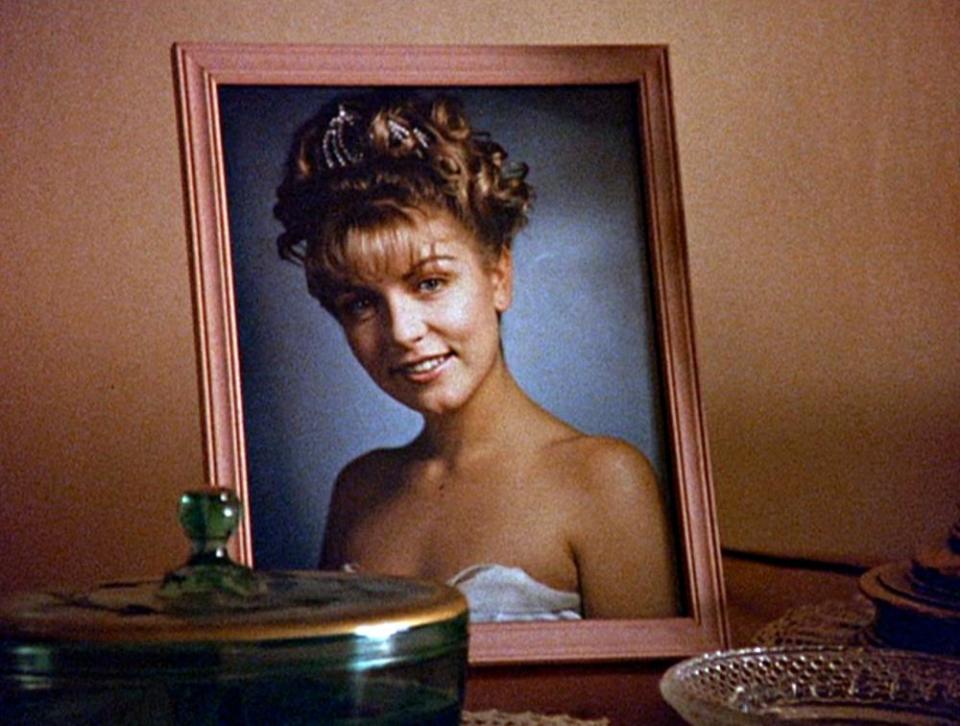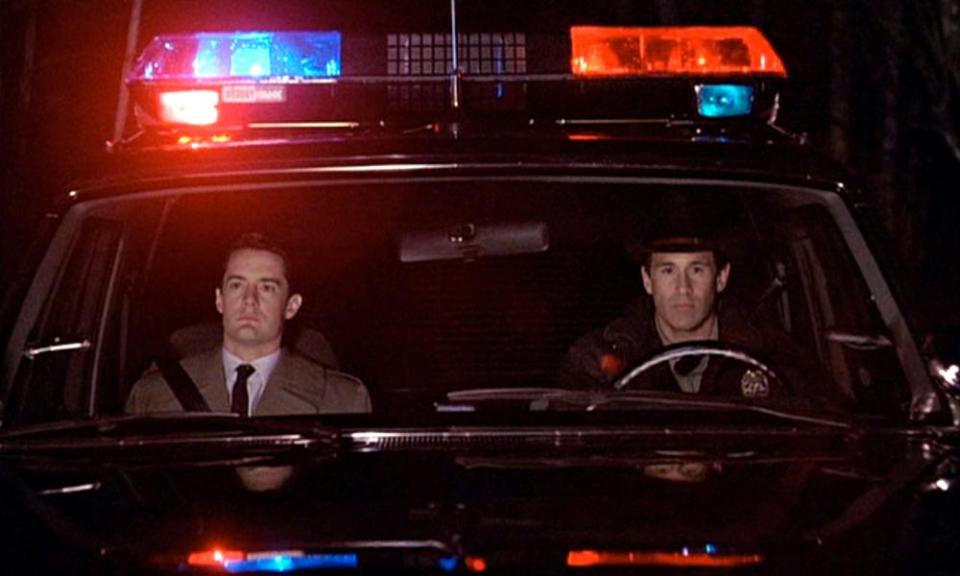Twin Peaks at 30: the weird and wonderful show that changed television
For cinephiles of a certain generation, the premiere of Twin Peaks on 8 April 1990 was a seismic event in popular culture, the sort of experience where you remember exactly where you were when you saw it. I was a senior in high school, working at a movie theater in suburban Atlanta, and I watched it alongside a concessionist with whom I used to trade enthusiasms about Marin Scorsese and Brian De Palma, and David Lynch’s Blue Velvet, which we had smuggled under our parents’ noses at the video store. It was the one and only time I’d ever spend at his house, and I don’t recall a word spoken between us until it was over. It was like nothing we had ever seen on television, and like nothing we had ever seen in a theater either.
Related: Fire Walk With Me: how David Lynch's film went from laughing stock to the key to Twin Peaks
Yet there are two important things about the pilot that tend to get forgotten over time. One is that Twin Peaks did not start as the cult phenomenon it would become later, as diehard fans clung to the series through diminishing ratings and a 1992 feature, Twin Peaks: Fire Walk With Me, that caught the zeitgeist too late. The pilot was a bonafide smash, the highest-rated of the 1989-90 season and the fifth ranked show of the week, and about 35 million Americans tuned into ABC to watch it. For perspective, only two primetime telecasts in 2019 had a higher viewership, and they were both football games. It was an impossible (and fleeting) moment when art infiltrated the mainstream, and the Sunday night mystery that introduced characters such as the Log Lady and Nadine, the eyepatch-wearing housewife with a drape obsession.
The other surprise, revisiting the pilot, is how emotion defines it as much as eccentricity. Twin Peaks is remembered as a strange show, and it would certainly get stranger as its mythology spun out over three seasons and a movie. The death of Laura Palmer (Sheryl Lee) would become a Lynchian mystery box that had no bottom, just an unending series of dark and surreal revelations about a secret, insinuating evil that lurked on the edges of an idyllic north-western town. But in the pilot, it’s treated more simply as a tsunami of grief that crashes over its characters, who have never experienced losing one of their own, which makes it seem like a sudden death in the everyone’s family. It’s not just Laura’s mother, Sarah (Grace Zabriskie), who breaks down in inconsolable anguish, but the high school principal delivering the news over the PA system and poor Andy (Harry Goaz), the crime scene photographer.

Four years earlier, Lynch had explored similar territory with Blue Velvet, which emphasized the innocence of small-town America in an opening sequence of shimmering green lawns and red roses, and a gleaming fire truck with a Dalmatian on the sideboard. Out of sight was a severed ear and some terrible, unacknowledged truths about what was happening in the shadows, and the arc of the film is Kyle MacLachlan’s naive hero confronting that darkness – and finding some of it within himself. In Twin Peaks, as in Blue Velvet, the concepts of good and evil and innocence and guilt are contrasted as sharply as those red roses against a white picket fence, where the distinction really pops.
Lynch and the show’s co-creator, Mark Frost, would have plenty of time to drift into the darkness, including the extra-dimensional terror within The Black Lodge, but the pilot puts a premium on collective decency. The fisherman who discovers the body, Pete Martell (Jack Nance), can’t bring himself to look at who has washed up onto the shoreline. All he can say, famously, to the police is, “She’s dead … wrapped in plastic,” and hide behind a rock as Sheriff Truman (Michael Ontkean) and the coroner, Dr Will Hayward (Warren Frost), peel back a layer to reveal her identity. (Hayward later refuses to perform the autopsy due to his close relationship to Laura, who’s his daughter’s best friend.)
As the news spreads from Sheriff Truman to the rest of the town, the grief spiderwebs out from the source. There’s no more affecting and brilliantly staged moment in the pilot than Leland Palmer (Ray Wise) fielding an emergency call at the Great Northern from his frantic wife, who had spent the morning searching for their daughter, and Truman’s police truck pulling up in the background behind him. Nothing needs to be said: Truman merely asking for Leland and the silence on the phone line makes it clear enough to the Palmers that Laura is dead, and it’s left to Zabriskie’s screams and the swells of Angelo Badalamenti’s score to carry the emotions from there.
The scene at the high school is equally elegant. Lynch has to introduce several major characters: Laura’s erratic boyfriend Bobby (Dana Ashbrook), the chief suspect, who’s seeing a married waitress, Shelly (Mädchen Amick) on the side; her best friend Donna (Lara Flynn Boyle); her secret squeeze James (James Marshall); and Audrey Horne (Sherilyn Fenn), a sultry chaos agent whose dad owns the Great Northern. Yet Laura’s loss is registered by her absence, an empty desk before roll call and some looks exchanged between Donna and James as their teacher is summoned to the hallway. The choked-up announcement from the principal (“Before we leave, I want to ask each of you to join me in a moment of silence for Laura and her dear memory”) is echoed later at the sawmill, where Josie Packard decides to shut down production. “Perhaps you can spend the day with your families,” she says.
And almost all of this happens before the first commercial break, and before Agent Dale Cooper (MacLachlan) turns up raving about the cherry pie at the Lamplighter and the fantastic Douglas fir trees in the area. Throughout the series’ run, there was so much talk about the cinematic qualities of Twin Peaks that not enough respect was given to how Lynch and Frost conceived it for television. The pilot is structured with commercial interruptions in mind, so viewers could carry certain images with them during the break: the portrait shot of Laura Palmer in happier times, Cooper pulling the letter R from under a victim’s fingernail, a reflection of James’ motorcycle in Laura’s eyes on a piece of video, a cut to the other half of an incriminating heart necklace.

It’s clear from watching Twin Peaks that Lynch and Frost were dedicated students of the primetime soap opera, and were drawing from its immense melodramatic pull as much as they were subverting it. The show lasted as long as it did as a network phenomenon because they teased out “Who killed Laura Palmer?” as a parallel universe version of “Who shot JR?” and jammed up the plot with love triangles and florid acts of betrayal and revenge. Part of it was about keeping viewers on the line while they smuggled stranger and more abstract ideas onto the show, but there’s also a genuine affection here for longstanding television conventions and the potential of serialization to lead the writers deeper down the rabbit hole.
Of course, there are still plenty of delectably weird standalone moments in the pilot, where Lynch and Frost trail off into offhand bits of poetry or small obsessions and enthusiasms. When Donna asks her little sister to cover for her while she sneaks out past curfew, she first has to answer which phrase she likes better, “the blossom of the evening” or “the full flower of the evening”. As part of his pitch to a group of Norwegian investors, Audrey’s father echoes a guest’s comment about his morning walk: “My airsacks have never felt so good.” And then there’s the general pattern of Agent Cooper’s dialogue, which pivots sharply between dazzling insight into the cases and non sequiturs about Douglas firs and the virtues of a clean, reasonably priced hotel.
“You know why I’m whittling?” Cooper ask Sheriff Truman on a stakeout. “That’s what you do in a town when a yellow light means slow down, not speed up.” Of all the memorable lines in the Twin Peaks pilot, that one might be the closest to a thesis statement. The show wouldn’t work if Cooper’s words had even a whiff of insincerity to them. Lynch and Frost believe in towns like Twin Peaks, and they believe in the closeness of communities that are rattled by tragedies of this magnitude. There may be pockets of evil under the surface, but there’s also a goodness that’s worth nurturing and protecting. To say nothing of a damn good cup of coffee.

